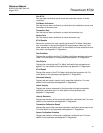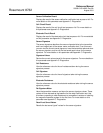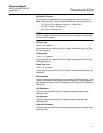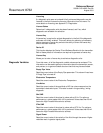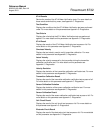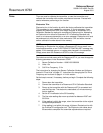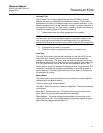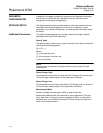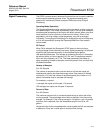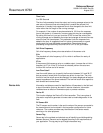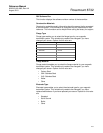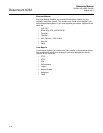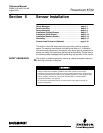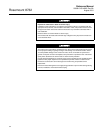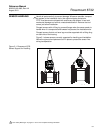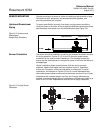
Reference Manual
00809-0100-4665, Rev AA
August 2010
4-13
Rosemount 8732
Signal Processing The 8732E contains several advanced functions that can be used to stabilize
erratic outputs caused by process noise. The signal processing menu
contains this functionality. Below is sample PDM screen shot of Signal
Processing.
Operating Mode (Operation)
The Operating Mode should be used only when the signal is noisy and gives
an unstable output. Filter mode automatically uses 37 Hz coil drive mode and
activates signal processing at the factory set default values. When using filter
mode, perform an auto zero with no flow and a full sensor. Either of the
parameters, coil drive mode or signal processing, may still be changed
individually. Turning Signal Processing off or changing the coil drive frequency
to 5 Hz will automatically change the Operating Mode from filter mode to
normal mode.
SP Control
When ON is selected, the Rosemount 8732E output is derived using a
running average of the individual flow inputs. Signal processing is a software
algorithm that examines the quality of the electrode signal against
user-specified tolerances. This average is updated at the rate of 10 samples
per second with a coil drive frequency of 5 Hz, and 75 samples per second
with a coil drive frequency of 37 Hz. The three parameters that make up
signal processing (number of samples, maximum percent limit, and time limit)
are described below.
Number of Samples
0 to 125 Samples
The number of samples function sets the amount of time that inputs are
collected and used to calculate the average value. Each second is divided
into tenths (1/10) with the number of samples equaling the number of 1/10
second increments used to calculate the average.
For example, a value of:
1 averages the inputs over the past 1/10 second
100 averages the inputs over the past 10 seconds
Percent of Rate
0 to 100 Percent
The maximum percent limit is a tolerance band set up on either side of the
running average. The percentage value refers to deviation from the running
average. For example, if the running average is 100 gal/min, and a 2 percent
maximum limit is selected, then the acceptable range is from 98 to 102
gal/min.
Values within the limit are accepted while values outside the limit are analyzed
to determine if they are a noise spike or an actual flow change.



